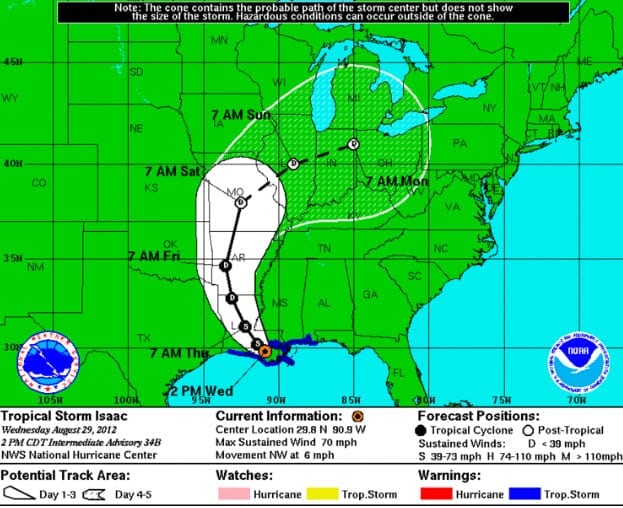
BOSTON, Aug. 29, 2012 – According to catastrophe modeling firm AIR Worldwide, by 7:00 AM CDT this morning (8:00 AM EDT), Isaac had made two separate landfalls, both as a Category 1 hurricane. The first occurred on August 28 at low-lying Plaquemines Parish, Louisiana, at around 7:45 PM CDT. Instead of continuing inland as expected, the storm veered sharply to the southwest and re-emerged over the water, which allowed it to maintain its strength. It then made a second landfall this morning just west of Port Fourchon, Louisiana, at around 2:15 AM CDT.
“The storm is still a Category 1 hurricane with maximum sustained wind speeds of 75 mph,” said Dr. Tim Doggett, principal scientist at AIR Worldwide. “The center of the storm is currently about 10 miles northwest of Houma Louisiana and it is moving NW at 6 mph with a central pressure of 973 mb. In southeastern Louisiana, sustained winds of 40-55 mph have been reported, with gusts as high as 100 mph. The area is being pelted with heavy rains along with gusty winds. Flooding and storm surge warnings are in effect. Heavy flooding has occurred in Plaquemines Parish, where a 9-foot earthen levee was overtopped. The water level at the Jourdan River, near Diamond Head, Mississippi, is expected to reach 9.5 feet over the next 24 hours; the river is currently at a moderate flood level of 8.7 feet.”
“High winds and saturated soil have allowed dozens of trees to be blown over causing damage, downed power lines, and road blockage. Some roof damage has been reported with several roofs being torn off homes from strong winds. In New Orleans, 6-10 inches of rain have fallen. Although some streets in the city have been made impassable by flooding from precipitation and downed trees, the fortified levees have held.”
Isaac has put to test the massive flood control system built in the area by the U.S. Army Corps of Engineers in response to Hurricane Katrina. The walls, levees, pumps, and huge floodgates are designed to withstand a Category 3 hurricane, equivalent to Hurricane Katrina. The system includes upgraded levees, and 73 floodgates in five parishes including a 2-mile floodgate that stands 26 feet high at the upper end of Lake Borgne. This barrier, the largest of its kind in the world, has been closed for the first time since it was built.
Isaac remains a large storm; hurricane force winds extend 60 miles from the center. Storm surge has been exacerbated by the storm’s slow forward speed.
Flooding is reported across an 18-mile area reaching from St. Bernard Parish south to White Ditch. Plaquemines Parish has up to 12 feet of water, and some homes in the Braithwaite area are submerged up to the rooftops. Elsewhere, a storm surge of up to 12 feet was reported at Shell Beach, Louisiana, and 3-5 feet of flooding has occurred in Biloxi Bay.
According to AIR, the majority of single-family homes along the Louisiana Coast are of wood-frame construction, with an exterior of masonry veneer. At the current Category 1 wind speeds, some of these structures could experience moderate damage to the roofs and exterior walls. Failure of roofing components would occur mainly because of improper fastening between the roof system and building frame. As the winds persist, roof fasteners and connections can become fatigued and overloaded causing additional damage. There is also the possibility of damage from flying building debris, such as roof tiles and shingles, which generally increases with increasing duration of high winds. Building codes and enforcement have also improved in recent years. In 2007, the state of Louisiana adopted statewide building codes. That same year, updated codes were also enforced in Baldwin County, Alabama, where they had been implemented earlier in 2001, in Mobile. Updated codes were also enforced in 2006 in five coastal counties in Mississippi. However, inland counties in Mississippi and Alabama are currently not covered by any statewide structural design regulations.
Earlier in Isaac’s trek through the Gulf, severe street flooding was reported in Palm Beach and Broward counties in Florida, and in Charleston, South Carolina. Wellington, Florida, has received 16 inches of rain since Sunday. A tornado spawned by Hurricane Isaac damaged homes in Vero Beach, Florida.
According to Dr. Doggett, “The storm is currently moving through a weak area in the subtropical ridge and its motion is uncertain. A mid-level anti-cyclone is expected to shift eastward over the continent in the coming days and will cause Isaac to turn towards the northeast. Now that the storm has moved inland, however, it should begin to weaken to tropical storm status later today and, finally, to a tropical depression by tomorrow. This is a slow-moving storm and heavy rains of 2-4 inches per hour are expected to continue, which would cause flooding to continue in the northern Gulf Coast through tomorrow.”
The area may receive up to 20 inches of rain, which could potentially cause damage to crops, particularly cotton, which is at 2/3 open boll.
According to several energy companies, over 520,000 homes and businesses in Arkansas, Alabama, Louisiana, and Mississippi are currently experiencing power outages. Most of these outages are in southeastern Louisiana.
Evacuations from platforms and rigs located offshore for oil and gas production continue from yesterday and according to the Bureau of Safety and Environmental Enforcement (BSEE), as of 11:30 AM August 28, out of the 596 manned oil and gas production platforms in the Gulf of Mexico, 503 (84%) have been evacuated.
AIR’s continues to monitor Isaac closely and will provide additional information on the development and impacts of this storm.
